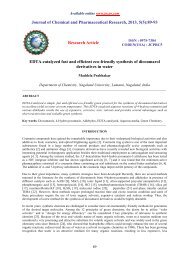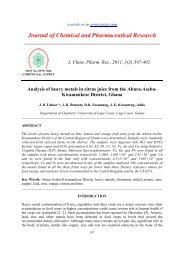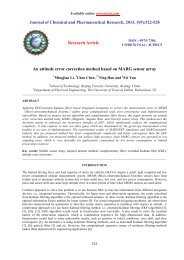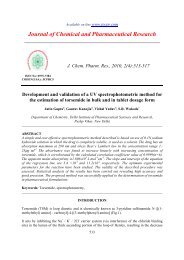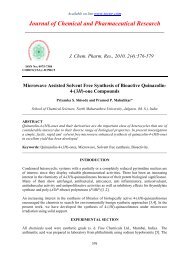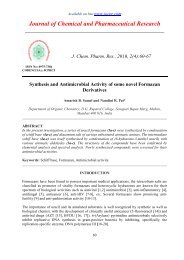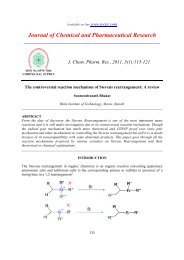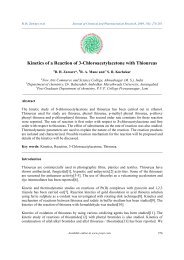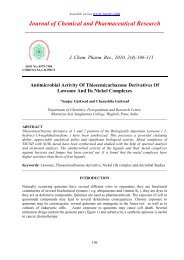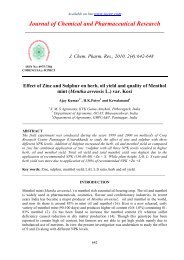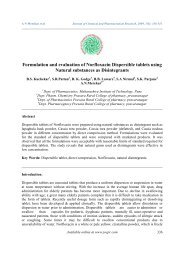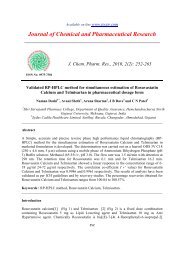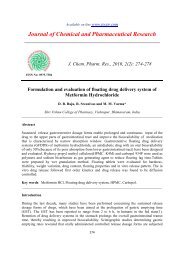Three analytical methods for determination of Epinastine ...
Three analytical methods for determination of Epinastine ...
Three analytical methods for determination of Epinastine ...
Create successful ePaper yourself
Turn your PDF publications into a flip-book with our unique Google optimized e-Paper software.
Ramzia I. El-Bagary et al J. Chem. Pharm. Res., 2012, 4(2):1361-1369______________________________________________________________________________volume <strong>of</strong> each flask in the first series was adjusted with 0.1N HCl and <strong>for</strong> the second series was adjusted with0.1N NaOH to give two series <strong>of</strong> equimolar solutions <strong>of</strong> EPH in two different pH media.Difference spectra were obtained by scanning the acidic solution (in 0.1N HCl) in the reference cell and the basicsolution (in 0.1N NaOH) in the sample cell. The values <strong>of</strong> absorbance difference at 252 nm were recorded andplotted versus the corresponding concentrations (µg. ml -1 ) <strong>of</strong> the drug to construct the calibration curve and toobtain the regression equation (1)which is stated in Table (2).b- For colorimetric method:Preparation <strong>of</strong> working standard solutions ranging from (20 to 220 µg.ml -1 ) <strong>of</strong> EPH was carried out by introducingaccurately measured aliquots equivalent to (0.1-1.1mg)<strong>of</strong> EPH from its standard stock solution (1mg.ml -1 ) into aseries <strong>of</strong> 5 ml volumetric flasks, followed by 1ml <strong>of</strong> CAA solution then the volume was completed with acetonitrileand mixed well. The absorbance at 517nm <strong>of</strong> the observed color were recorded <strong>for</strong> each flask against itscorresponding blank and plotted versus the corresponding concentrations(µg. ml -1 ) <strong>of</strong> the drug to construct thecalibration curve and to obtain the regression equation (2)which is stated in Table (2).c-For HPLC method:Appropriate aliquots <strong>of</strong> EPH standard stock solution (1 mg.ml -1 ) were transferred into a series <strong>of</strong> 10 ml volumetricflasks, 0.1 ml <strong>of</strong> methyl paraben internal standard solution was added to each flask , then the volume <strong>of</strong> each flaskwas diluted with methanol to obtain working standard solutions ranging from (20-100 mg.ml -1 ).Twenty µl triplicate injections <strong>of</strong> each working standard solution were injected into the chromatographic systemusing a lichrocart 10 µm C18 column.The elution was carried out using acetonitrile: 0.1M ammonium acetate buffer (40:60 v/v) at a flow rate 1 ml/minand uv detection at 262nm.The chromatograms were developed and the ratios <strong>of</strong> the peak areas <strong>of</strong> EPH to those <strong>of</strong> internal standard wererecorded <strong>for</strong> each concentration <strong>of</strong> drug solution. The calibration graph was obtained by plotting the relative peakarea ratios versus the corresponding concentrations (µg. ml -1 ) <strong>of</strong> the drug to construct the calibration curve and toobtain the regression equation (3) which is stated in Table (2).2.6. Determination <strong>of</strong> EPH in “Relestat” eye drops:a-Difference method:Four ml aliquot <strong>of</strong> the eye drop solution (containing 2000µg <strong>of</strong> EPH) was diluted with methanol in a 10 mlvolumetric flask to get a final concentration <strong>of</strong> 200µg.ml -1 . Different aliquots equivalent to (30-70 µg.ml -1 ) weretreated as previously mentioned under general procedure and linearity.The same procedure was repeated applying the standard addition technique. The absorbance difference (∆A) at252nm were used to calculate the concentration <strong>of</strong> eye drops solution and the added authentic using eq.(1).b-For colorimetric method:Twenty ml aliquot <strong>of</strong> ”Relestat” eye drops was shaken in a separating funnel with 10 ml <strong>of</strong> 10% Na 2 CO 3 solutionthen extracted three times each with 25 ml <strong>of</strong> chloro<strong>for</strong>m. The collected chloro<strong>for</strong>mic extracts were evaporated andthe residue was dissolved quantitatively in methanol to 10 ml volume (final concentration 1 mg.ml -1 ). Differentaliquots equivalent to (20-140 µg.ml -1 ) were treated as previously mentioned under general procedure and linearity.The same procedure was repeated applying the standard addition technique. The absorbance at 517nm was used tocalculate the concentration <strong>of</strong> eye drops solution and the added authentic using eq.(2).c-For HPLC method:An aliquot <strong>of</strong> the eye drop solution was diluted with methanol to get a solution <strong>of</strong> 1 mg. ml -1 <strong>of</strong> EPH. Differentaliquots equivalent to (20-70 µg.ml -1 ) were treated as previously mentioned under general procedure and linearity.The same procedure was repeated applying the standard addition technique. The detection at 262nm was used tocalculate the concentration <strong>of</strong> eye drops solution and the added authentic using eq.(3).1363



